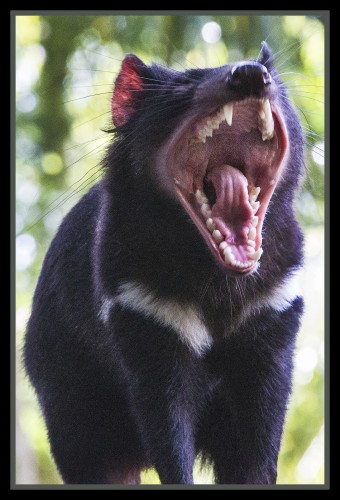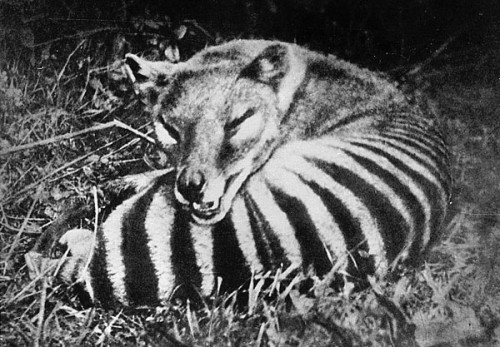 First, if you please, a moment of silence for the thylacine.
First, if you please, a moment of silence for the thylacine.
The Tasmanian tiger, last seen in the wild in 1930, was once Tasmania’s top predator, snacking on possums, wallabies, and the unlucky Tasmanian emu. (Despite persistent rumors, the thylacine did not drink blood. Sorry.)
When European settlers arrived, bringing feral dogs, habitat destruction and bounty hunters, the thylacine declined in Tasmania and on the Australian mainland, and all but a few diehard thylacine believers agree that the thylacine is gone. (It may not be gone for good, but that’s another story.)
For the last century or so, Tasmania’s top-predator post has been held by another carnivorous marsupial — the smaller but equally fierce-looking Tasmanian devil. European settlers managed not to hunt these little guys to death, but devils are now well-known as the victims of a contagious cancer — devil facial tumor disease — and are close to extinction themselves. Captive breeding programs are working to save the species, but the outlook for wild populations is grim at best.
If the devil goes the way of the thylacine, who will be left in charge?
Researchers from the University of Tasmania recently analyzed wildlife surveys performed before and after the onset of devil facial tumor disease, and found that in many cases, the longer the disease had been present in a particular area, the larger the area’s population of feral cats. More cats make trouble for native species like the eastern quoll, a ferrety marsupial which appears to be declining as cats multiply.
devil facial tumor disease, and found that in many cases, the longer the disease had been present in a particular area, the larger the area’s population of feral cats. More cats make trouble for native species like the eastern quoll, a ferrety marsupial which appears to be declining as cats multiply.
As the devil disappears, Tasmania is going to the cats.
The thylacine-devil-feral cat succession appears to be a textbook example of a top-down trophic cascade, where the elimination of a top predator causes a boom in its prey — and a consequent power shift that’s felt throughout the food web. Ecologists don’t debate the reality of trophic cascades, but they do argue over how common they are in nature, and whether they’re controlled more strongly from the top (the number and appetite of the largest predators) or the bottom (the availability of plants and the smallest prey). The Tasmanian data gave researchers a melancholy but valuable opportunity to study a cascade as extinction transformed its flow.
The Tasmanian cascade, they found, is controlled from the top — except when it’s not. The devils appeared to be the primary influence on feral-cat numbers in wetter, wilder areas of Tasmania; in drier, more settled places, however, feral cat numbers were determined most strongly by the numbers of rabbits, a favorite feral-cat treat.
In ecology, as in so much else, the devil is in the details.
Top: Tasmanian devil photo by Flickr user Sheba_Also.
Bottom: Napping thylacine photo from the Museum Victoria Image Collection.
Michelle, A nicely researched article about an obscure (at least generally but maybe not in Tasmania)topic. I’m sorry to hear the ‘devils”
are in such trouble.
Seriously, it took me half the article to figure out that thylacine was not some obscure pain drug. What an odd name. Where’s it from?
Greek for “dog-headed pouched one” (according to Wikipedia). Not on the list of 1,000 most popular baby names.